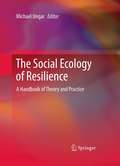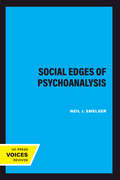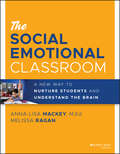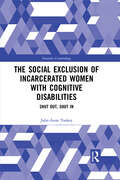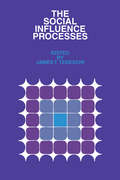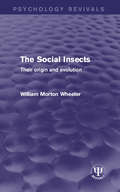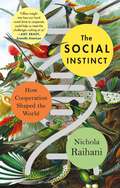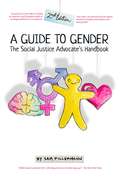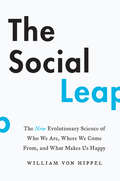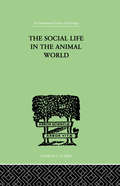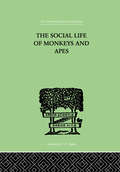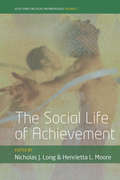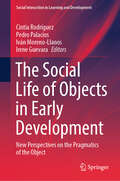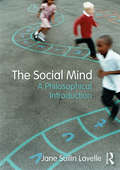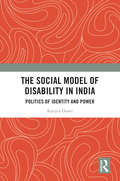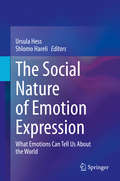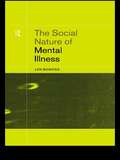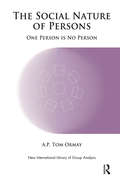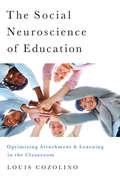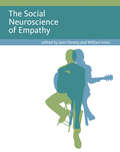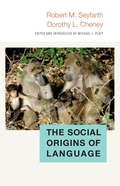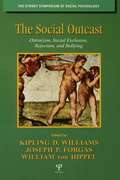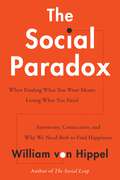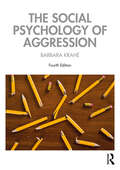- Table View
- List View
The Social Ecology of Resilience
by Michael UngarMore than two decades after Michael Rutter (1987) published his summary of protective processes associated with resilience, researchers continue to report definitional ambiguity in how to define and operationalize positive development under adversity. The problem has been partially the result of a dominant view of resilience as something individuals have, rather than as a process that families, schools,communities and governments facilitate. Because resilience is related to the presence of social risk factors, there is a need for an ecological interpretation of the construct that acknowledges the importance of people's interactions with their environments. The Social Ecology of Resilience provides evidence for this ecological understanding of resilience in ways that help to resolve both definition and measurement problems.
The Social Edges of Psychoanalysis
by Neil J. SmelserFor several decades the writings of sociologist Neil J. Smelser have won him a vast and admiring audience across several disciplines. Best known for his work on social movements, economic sociology, and British social history, Smelser's psychoanalytic writings are less familiar to his readers. In fact, many people are completely unaware of Smelser's formal psychoanalytic training and ongoing counseling practice. With the publication of The Social Edges of Psychoanalysis, Smelser's thought-provoking essays on psychoanalytic concepts are finally brought together in one book.Psychoanalytic theory has had an ambivalent relationship with sociology, and these essays explore that ambivalence, providing arguments about how and why psychoanalytic approaches can deepen the sociological perspective. One of Smelser's main tenets is that human social behavior always contains both social-structural and social-psychological elements, and that psychoanalytic theory can bridge these two dimensions of human social life. Many of the issues Smelser addresses—including interdisciplinarity, the macro-micro link in research, masculinity and violence, and affirmative action—have generated considerable scholarly interest.This collection paves the way for further articulation of the relationship between sociology and psychoanalysis at a time when many sociologists are looking for interdisciplinary links in their work. Presented with clarity and grace, and free of the murkiness often found in both sociological and psychoanalytic writing, Smelser's new book will excite reflection and research on the less visible dynamics of social existence.
The Social Emotional Classroom: A New Way to Nurture Students and Understand the Brain
by Anna-Lisa Mackey Melissa RaganLearn to implement powerful new learning techniques in your classroom experience In The Social Emotional Classroom, celebrated educators and authors Anna-Lisa Mackey and Melissa Ragan deliver an insightful, rigorous, and accessible treatment of social emotional learning in education. Using research from the Theory of Constructed Emotion, the authors highlight the relationship between the new view of neurobiology and Social Emotional Learning. The book connects five key competencies, including self-awareness, social awareness, self-management, responsible decision-making, and relationship skills, to this new understanding of the brain. You'll also learn from: Teacher stories included in each chapter The inclusion of over two decades worth of experience and research in the field of social and emotional learning Instructions and guides for educators to embed social and emotional learning into their everyday practices Perfect for K-12 educators, principals, superintendents, and other education leaders, The Social Emotional Classroom will also earn a place in the libraries of parents and caregivers who are responsible for young people's day-to-day learning.
The Social Exclusion of Incarcerated Women with Cognitive Disabilities: Shut Out, Shut In (Feminist Criminology)
by Julie-Anne TooheyThe Social Exclusion of Incarcerated Women with Cognitive Disabilities explores the lived experience of cognitively disabled women incarcerated in Australia. It draws upon in-depth interviews with Indigenous and non-Indigenous women, as well as interviews conducted with prison practitioners – psychologists, counsellors, and Aboriginal Liaison Officers. Using a theoretical framework of social exclusion, the book charts the complex intersection between cognitively disabled women and the Criminal Justice System, and how this connection works to foster and maintain a state of social exclusion prior to incarceration, and equally, within the prison setting. The book also provides a practical template for other researchers to use when investigating the aligned fields of the Criminal Justice System and incarceration, women offenders, cognitive disability, and social exclusion. By placing the voices of the incarcerated women with cognitive disabilities ‘front and centre’, a new and innovative approach to social exclusion emerges. The book moves beyond the 'telling of sad stories' to examine the social and political climate that permits disadvantage, inequality, and injustice to flourish. This book will be of great interest to academics and students in criminology, criminal justice, disability studies, women’s and gender studies, and penology. In exploring theory in a practical way, it will also be of use to those involved in the health sector, community services, disability support agencies, disability advocates, prisoner advocacy, women’s studies and women’s advocacy, and human rights activism.
The Social Influence Processes
by James T. TedeschiSocial psychologists have always been concerned with two-person interactions and the factors enabling one person to gain dominance. Although social psychology has devised a revolutionary set of techniques to investigate the phenomenon of power, hypotheses are too often ambiguously stated, research programs end in cul-de-sacs, and experiments take on the character of one-shot studies. In an attempt to stimulate new directions in research and to provide cumulative emphasis on the development of scientific theory in the area of power relations, Tedeschi has assembled original and path breaking essays from a dozen outstanding scholars and researchers in the behavioral sciences.More tightly integrated than leading books in the field of power relations, The Social Influence Processes focuses on two-person interactions. A full explanation of the terms "power" and "influence" is followed by an analysis of the major variables in connections between two persons that must be taken into account in a scientific theory of social influence. The subsequent chapters respond to the categories established, attempting a comprehensive construction of social reality and offering suggestions and techniques for measuring and ordering its complexity. Particular areas of research and theory are isolated for consideration in depth--such topics as personality as a power construct (Power and Personality by Henry L. Minton), influence in exchange theory (The Tactical Use of Social Power by Andrew Michener and Robert W. Suchner), and leadership through charisma (Interpersonal Attraction and Social Influence by Elaine Walster and Darcy Abrahams). In the final chapter, Tedeschi, Thomas Bonoma, and Barry R. Schlenker attempt to provide a general theory of social influence processes as they affect the target individual by reviewing the research literature in their own theoretical terms.This remarkable volume will be of interest to students as well
The Social Insects: Their Origin and Evolution (Psychology Revivals)
by William Morton WheelerOriginally published in 1928, this volume, by a world authority on the subject, sums up our knowledge of the social insects. It inquires what are the social insects and what it is that makes us call them ‘social’. Terebrantia, aculeata, wasps, bees, ants, and termites are discussed in a succession of chapters, showing how they have evolved, to how great an extent they have developed, and what are the peculiarities of their evolution. Polymorphism, the Social Medium, Guests and Parasites of the Social Insects, are other subjects discussed in this fascinating book.
The Social Instinct: How Cooperation Shaped the World
by Nichola Raihani"Enriching" —Publisher's Weekly"Excellent and illuminating"—Wall Street JournalIn the tradition of Richard Dawkins's The Selfish Gene, Nichola Raihani's The Social Instinct is a profound and engaging look at the hidden relationships underpinning human evolution, and why cooperation is key to our future survival.Cooperation is the means by which life arose in the first place. It’s how we progressed through scale and complexity, from free-floating strands of genetic material, to nation states. But given what we know about the mechanisms of evolution, cooperation is also something of a puzzle. How does cooperation begin, when on a Darwinian level, all that the genes in your body care about is being passed on to the next generation? Why do meerkat colonies care for one another’s children? Why do babbler birds in the Kalahari form colonies in which only a single pair breeds? And how come some coral wrasse fish actually punish each other for harming fish from another species?A biologist by training, Raihani looks at where and how collaborative behavior emerges throughout the animal kingdom, and what problems it solves. She reveals that the species that exhibit cooperative behavior–teaching, helping, grooming, and self-sacrifice–most similar to our own tend not to be other apes; they are birds, insects, and fish, occupying far more distant branches of the evolutionary tree. By understanding the problems they face, and how they cooperate to solve them, we can glimpse how human cooperation first evolved. And we can also understand what it is about the way we cooperate that has made humans so distinctive–and so successful.
The Social Justice Advocate's Handbook: A Guide to Gender (Second Edition)
by Sam KillermannWhere do we start, when it comes to learning about something that's everywhere, infused into everything, and is often one of the primary lenses through which we see ourselves and others? When it comes to understanding gender, it's best to begin with deep breath, then with section one of this book by social justice advocate Sam Killermann, who uses clear language, helpful examples, and a bit of humor to help the medicine go down. This book is not overwhelming, it's not overly complicated, and it's not exhausting to read. It is a few hundred pages of gender exploration, social justice how-tos, practical resources, and fun graphics & comics. Sam dissects gender using a comprehensive, non-binary toolkit, with a focus on making this subject accessible and enjoyable. All this to help you understand something that is so commonly misunderstood, but something we all think we get: gender.
The Social Leap: The New Evolutionary Science of Who We Are, Where We Come From, and What Makes Us Happy
by William von HippelA study of how evolution has forged our modern lives—from work and relationships to leadership and innovation, as well as our quest for happiness. Human psychology is rife with contradictions: We work hard to achieve our goals, but happiness at our success is fleeting. We hope our friends will do well in life but can&’t help feeling jealous if they do too well. We&’re aghast at the thought of people we know being murdered but are unconcerned when our armed forces kill enemies we&’ve never met. We complain about difficult bosses but are often just as bad when we&’re in charge. These inconsistencies may seem irrational, but each of them has evolved to serve a vital function in our lives. Indeed, the most fundamental aspects of our psychology were permanently shaped by the &“social leap&” our ancestors made from the rainforest to the savannah. In their struggle to survive on the open grasslands, our ancestors prioritized teamwork and sociality over physical prowess, creating an entirely new kind of intelligence that would forever alter our place on this planet. A blend of anthropology, biology, history, and psychology with evolutionary science, The Social Leap traces our evolutionary history to show how events in our distant past continue to shape our lives today. From why we exaggerate to why we believe our own lies, the implications are far-reaching and extraordinary.Praise for The Social LeapWinner of the Society for Personality and Social Psychology Book Prize&“A rollicking tour through humanity&’s evolutionary past. . . . Von Hippel shows how our past explains the present and why our well-being rests on an understanding of how our minds evolved.&” —Adam Alter, New York Times–bestselling author of Irresistible&“Full of insight into human character, von Hippel&’s book provides a stimulating program for measuring success without material yardsticks.&” —Kirkus Reviews
The Social Life In The Animal World
by Alverdes, FrFirst Published in 1999. Routledge is an imprint of Taylor & Francis, an informa company.
The Social Life Of Monkeys And Apes (International Library Of Psychology Ser.)
by Zuckerman, SFirst Published in 1999. Routledge is an imprint of Taylor & Francis, an informa company.
The Social Life of Achievement
by Nicholas J. Long Henrietta L. MooreWhat happens when people "achieve"? Why do reactions to "achievement" vary so profoundly? And how might an anthropological study of achievement and its consequences allow us to develop a more nuanced model of the motivated agency that operates in the social world? These questions lie at the heart of this volume. Drawing on research from Southeast Asia, Europe, the United States, and Latin America, this collection develops an innovative framework for explaining achievement's multiple effects-one which brings together cutting-edge theoretical insights into politics, psychology, ethics, materiality, aurality, embodiment, affect and narrative. In doing so, the volume advances a new agenda for the study of achievement within anthropology, emphasizing the significance of achievement as a moment of cultural invention, and the complexity of "the achiever" as a subject position.
The Social Life of Children in a Changing Society
by Kathryn M. BormanThis book developed from a symposium in which participants examined childhood socialization from a number of perspectives and with several disciplinary lenses. The major purpose of the symposium and thus of this volume is to provide an integrative, multidisciplinary discussion of the social development of preschool and young elementary school-aged children. As a result, there are contributions to this volume from anthropologists (Leacock, Ogbu), psychologists (Lippincott, Mueller, Ramey and Snow), sociologists (Borman, Denzin) and scholars who have self-consciously adopted an interdisciplinary framework. First published in 1984. Routledge is an imprint of Taylor & Francis, an informa company.
The Social Life of Objects in Early Development: New Perspectives on the Pragmatics of the Object (Social Interaction in Learning and Development)
by Cintia Rodríguez Pedro Palacios Iván Moreno-Llanos Irene GuevaraThis book fills a gap in early developmental psychology by providing a critical reconsideration of the status of artifact objects as protagonists of children's actions and communication. The main thesis explored in the book is that objects are part of the material culture; they have public functions and social meanings that are transmitted by the members of the community. Their meanings are not "naturally" given, and children are not born knowing what to do with objects. All chapters analyze and illustrate communication with parents, or with teachers and peers in the early-years school. The book also explores the status of action and uses of materiality in communicative situations with children on the autism spectrum. The book shows objects coming alive in action and in communication, shaping the social foundations and early development of the human psyche. The book is intended for use by scholars and researchers in developmental psychology, teachers in early childhood education (mainly 0-3 years), undergraduate and postgraduate students in the fields of psychology and education, and sociocultural psychologists interested in early development.
The Social Mind: A Philosophical Introduction
by Jane Suilin LavelleWe spend a lot of time thinking about other people: their motivations, what they are thinking, why they want particular things. Sometimes we are aware of it, but it often occurs without conscious thought, and we can respond appropriately to other people's thoughts in a diverse range of situations. The Social Mind: A Philosophical Introduction examines the cognitive capacities that facilitate this amazing ability. It explains and critiques key philosophical theories about how we think about other people's minds, measuring them against empirical findings from neuroscience, anthropology, developmental psychology and cognitive ethology.
The Social Model of Disability in India: Politics of Identity and Power
by Ranjita DawnThis book presents various paradigms and debates on the diverse issues concerning disability in India from a sociological perspective. It studies disability in the context of its relationship with concepts such as culture/religion, media, literature, and gender to address the inherent failures in challenging prevalent stereotypical and oppressive ideologies. It traces the theological history of disability and studies the present-day universalized social notions of disablement. The volume challenges the predominant perception of disability being only a medical or biological concern and provides deeper insight into the impact of representation through an analysis of the discourse and criteria for ‘normalcy’ in films from the nineteenth and twentieth centuries. It analyzes the formation of perspectives through a study of representation of disability in print media, especially children’s literature, comics, and graphic novels. The author also discusses the policies and provisions available in India for students with disabilities, especially women who have to also contend with gender inequality and gender-based discrimination. The book will be of interest to scholars and researchers of disability studies, educational psychology, special education, sociology, gender studies, politics of education, and media ecology. It will also be useful for educationalists, NGOs, special educators, disability specialists, media and communication professionals, and counsellors.
The Social Nature of Emotion Expression: What Emotions Can Tell Us About the World
by Ursula Hess Shlomo HareliThis book provides an overview of theoretical thinking about the communicative scope of emotional expressions as well as an overview of the state of the art research in emotional psychology. For many years, research in emotional psychology has been primarily concerned with the labeling of emotion expressions and the link between emotion expressions and the expresser’s internal state. Following recent trends in research devoting specific attention to the social signal value of emotions, contributors emphasize the nature of emotion expressions as information about the person and the situation, including the social norms and standards relevant to the situation.Focusing on the role of emotion expressions as communicative acts, this timely book seeks to advance a line of theoretical thinking that goes beyond the view of emotion expressions as symptoms of an intrapersonal phenomenon to focus on their interpersonal function. The Social Nature of Emotion Expression will be of interest to researchers in emotional psychology, as well as specialists in nonverbal behavior, communication, linguistics, ethology and ethnography.
The Social Nature of Mental Illness
by Dr. Leonard BowersPsychiatrists assert that mental illness is a physiological brain disorder. The anti-psychiatry movement refutes this on grounds of lack of evidence claiming that mental illness is socially defined. Len Bowers offers a rational, objective and philosophical critique of the theories of mental illness as a social construct and concludes that, though sometimes misguided, they cannot be wholly rejected. This critical scrutiny of a controversial and keenly-debated issue will be of interest to psychologists, social workers, psychiatrists, sociologists and professionals in paramedical disciplines.
The Social Nature of Persons: One Person is No Person (The New International Library of Group Analysis)
by A.P. Tom OrmayThis book is a theoretical study of many interconnected facets of the social unconscious and the social "part" of the personality. It takes us from what we thought we knew, and knew we thought, to the un-thought and the unknown, which is, indeed, both disturbing and creative.
The Social Neuroscience of Education: Optimizing Attachment and Learning in the Classroom (The Norton Series on the Social Neuroscience of Education)
by Louis CozolinoCreating a healthy, social classroom environment. This book explains how the brain, as a social organism, learns best throughout the lifespan, from our early schooling through late life. Positioning the brain as distinctly social, Louis Cozolino helps teachers make connections to neurobiological principles, with the goal of creating classrooms that nurture healthy attachment patterns and resilient psyches. Cozolino investigates what good teachers do to stimulate minds and brains to learn, especially when they succeed with difficult or "unteachable" students. He explores classroom teaching from the perspectives of social neuroscience and interpersonal neurobiology, showing how we can use the findings from these fields to maximize learning and stimulate the brain to grow. The book will have relevance to anyone concerned with twenty-first century learners and the social and emotional development of children.
The Social Neuroscience of Empathy (Social Neuroscience)
by Jean Decety William IckesCross-disciplinary, cutting-edge work on human empathy from the perspectives of social, cognitive, developmental and clinical psychology and cognitive/affective neuroscience.In recent decades, empathy research has blossomed into a vibrant and multidisciplinary field of study. The social neuroscience approach to the subject is premised on the idea that studying empathy at multiple levels (biological, cognitive, and social) will lead to a more comprehensive understanding of how other people's thoughts and feelings can affect our own thoughts, feelings, and behavior. In these cutting-edge contributions, leading advocates of the multilevel approach view empathy from the perspectives of social, cognitive, developmental and clinical psychology and cognitive/affective neuroscience. Chapters include a critical examination of the various definitions of the empathy construct; surveys of major research traditions based on these differing views (including empathy as emotional contagion, as the projection of one's own thoughts and feelings, and as a fundamental aspect of social development); clinical and applied perspectives, including psychotherapy and the study of empathy for other people's pain; various neuroscience perspectives; and discussions of empathy's evolutionary and neuroanatomical histories, with a special focus on neuroanatomical continuities and differences across the phylogenetic spectrum. The new discipline of social neuroscience bridges disciplines and levels of analysis. In this volume, the contributors' state-of-the-art investigations of empathy from a social neuroscience perspective vividly illustrate the potential benefits of such cross-disciplinary integration.ContributorsC. Daniel Batson, James Blair, Karina Blair, Jerold D. Bozarth, Anne Buysse, Susan F. Butler, Michael Carlin, C. Sue Carter, Kenneth D. Craig, Mirella Dapretto, Jean Decety, Mathias Dekeyser, Ap Dijksterhuis, Robert Elliott, Natalie D. Eggum, Nancy Eisenberg, Norma Deitch Feshbach, Seymour Feshbach, Liesbet Goubert, Leslie S. Greenberg, Elaine Hatfield, James Harris, William Ickes, Claus Lamm, Yen-Chi Le, Mia Leijssen, Abigail Marsh, Raymond S. Nickerson, Jennifer H. Pfeifer, Stephen W. Porges, Richard L. Rapson, Simone G. Shamay-Tsoory, Rick B. van Baaren, Matthijs L. van Leeuwen, Andries van der Leij, Jeanne C. Watson
The Social Origins of Language
by Robert M. Seyfarth Dorothy L. Cheney Michael L. PlattHow human language evolved from the need for social communicationThe origins of human language remain hotly debated. Despite growing appreciation of cognitive and neural continuity between humans and other animals, an evolutionary account of human language—in its modern form—remains as elusive as ever. The Social Origins of Language provides a novel perspective on this question and charts a new path toward its resolution.In the lead essay, Robert Seyfarth and Dorothy Cheney draw on their decades-long pioneering research on monkeys and baboons in the wild to show how primates use vocalizations to modulate social dynamics. They argue that key elements of human language emerged from the need to decipher and encode complex social interactions. In other words, social communication is the biological foundation upon which evolution built more complex language.Seyfarth and Cheney’s argument serves as a jumping-off point for responses by John McWhorter, Ljiljana Progovac, Jennifer E. Arnold, Benjamin Wilson, Christopher I. Petkov and Peter Godfrey-Smith, each of whom draw on their respective expertise in linguistics, neuroscience, philosophy, and psychology. Michael Platt provides an introduction, Seyfarth and Cheney a concluding essay. Ultimately, The Social Origins of Language offers thought-provoking viewpoints on how human language evolved.
The Social Outcast: Ostracism, Social Exclusion, Rejection, and Bullying (Sydney Symposium of Social Psychology #Vol. 7)
by Kipling D. Williams William Von Hippel Joseph P. ForgasThis book focuses on the ubiquitous and powerful effects of ostracism, social exclusion, rejection, and bullying. Human beings are an intrinsically gregarious species. Most of our evolutionary success is no doubt due to our highly developed ability to cooperate and interact with each other. It is thus not surprising that instances of interpersonal rejection and social exclusion would have an enormously detrimental impact on the individual. Until 10 years ago, however, social psychology regarded ostracism, rejection and social exclusion as merely outcomes to be avoided, but we knew very little about their antecedents and consequences, and about the processes involved when they occurred. Furthermore, the literatures of ostracism, social exclusion and rejection have not until now included discussions of the bullying literature.
The Social Paradox: Autonomy, Connection, and Why We Need Both to Find Happiness
by William von HippelA Next Big Idea Club Must Read of February 2025From the author of The Social Leap comes this thought-provoking exploration into humans’ two core evolutionary needs, for connection and autonomy, how the modern world has thrown them out of whack, and how we can rebalance them to improve our lives.Why do people who have so much—leading comfortable lives filled with unprecedented freedom, choice, and abundance—often feel so unhappy and unfulfilled? This phenomenon is a defining paradox of our time and one we endlessly seek to solve. In The Social Paradox, psychologist William von Hippel argues that we need to think about this problem in a new way. By changing our perspective, we might finally see the solution, bringing us greater happiness and more satisfying relationships.The key is to understand the interplay between our two most basic psychological needs—for connection and autonomy. Evolution made us dependent on one another for survival, instilling in us a strong need to connect. It also made us seek autonomy, so our ancestors could distinguish themselves within their groups, improving their chances to procreate and gain status.These two opposing needs are our most fundamental psychological drivers, and while our lives once ensured a happy balance between them, the opportunities of today’s world have thrown it out of whack. As von Hippel explains, our modern world no longer demands connection but it provides endless opportunity for autonomy; this lopsidedness lies at the root of many of our most intractable problems. Recognizing this imbalance and working to counter it can drastically change how we make decisions, spend our time, and find happiness.The Social Paradox invites us to examine the fundamental building blocks of life and society—politics, religion, urban living, marriage—in a brand-new way. Once we understand the evolutionary forces driving us, we can begin to see how to counteract the emptiness and loneliness of contemporary life.
The Social Psychology of Aggression
by Barbara KrahéThe fourth edition of this best-selling textbook offers a comprehensive and up-to-date overview of the social psychology of aggression, covering all the relevant major theories, individual differences, situational factors, and applied contexts.The book examines a range of topics that can help us understand the causes, forms, and consequences of aggression and violence in order to better address these harmful forms of social behaviour. Initial chapters cover the definition and measurement of aggression, examine the development of aggression, and cover the role of situational factors in eliciting aggression and the impact of using violent media. The second part of the book focusses on specific forms and manifestations of aggression, including chapters on aggression in everyday life and in the family, sexual aggression, intergroup aggression, and terrorism. The final chapter presents strategies for reducing and preventing aggression. The new edition also includes additional coverage of aggression and violent behaviour that stems from the COVID-19 pandemic, new sections on the transfer of aggression from the virtual to the real world, as well as cyberbullying, online sexual aggression, and aggressive fantasies.Accessibly written and featuring chapter summaries, tasks, and strategies for reducing and preventing aggression, this book is essential reading for students of psychology and sociology who study aggression and violence. It will also be of interest to practitioners working with aggressive individuals and groups, and to policy makers dealing with aggression as a social problem.
